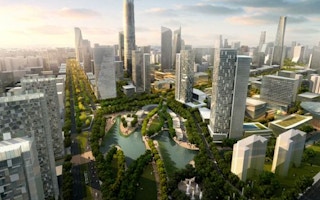China’s rapidly growing cities are taking centrestage in the country’s plans for sustainable, low-carbon development, and urban leaders are finding increasing benefits to sharing expertise and resources to support clean tech industries there. Smart grids and improved energy management will be central to that discussion.
At this month’s UrbanTec China Conference at CIFTIS 2012 in Beijing, CPPCC Beijing Municipal Committee Vice Chairman Cai Guoxiong will share his expertise on clean energy for smart cities. An expert on smart grids and electric vehicles, the Tokyo-born Chinese national is also a deputy chief engineer at the China Electric Power Research Institute (CEPRI) who graduated from the Kunming Institute of Technology and received his doctorate from Japan’s Nagoya University.
Eco-Business recently caught up with Mr Cai for a preview of the discussion.
Guoxiong Cai, Vice Chairman of CPPCC Beijing Municipal Committee
Eco-Business: To what extent do you think low-carbon cities can reduce China’s energy demand?
The economy of China is growing rapidly, leading to higher energy consumption every year. Consider, for instance, that an annual GDP growth of 8 per cent will result in a similar increase in energy consumption. It is true that low-carbon cities will decrease energy demand; however, the effect is limited when compared with total energy growth.
Total residential consumption is only about 12 per cent of electricity use, meaning that the majority of energy consumption comes from other areas. So despite the efforts of low-carbon cities to save energy within residential green buildings, the effect is relatively small. We need more effort on increasing the energy efficiency in other sectors. This does not mean residential green buildings are of less importance in the construction of low-carbon cities. In the future, these projects will also play an important role in strongly influencing people’s habits.
EB: China has set a target of having a national smart grid infrastructure by 2015. How quickly has the industry been growing in terms of investment, skills development and infrastructure; and is this growth sufficient to meet the target?
People have different concepts of smart grids, and the goals differ according to how you define them. We think it’s possible to make tremendous progress in terms of infrastructure and equipment installation for electricity generation and supply, including equipment for power plants, transmission lines and sub-stations. We can also make progress in the field of electricity metering.
However, this is only the first stage and there is still a long way to go towards the completion of an ideal smart grid. Since the grid also depends on the establishment of an electricity market, the government will have to develop suitable policy changes.
EB: Recently, media has reported that electric vehicle uptake is not on track to meet targets. Why is this so, and what are the measures that industry and governments can take to remedy this?
Electric vehicles have been used widely in Beijing and other large cities in China since the successful opening of the Beijing Olympics. These electric vehicles were mainly used for public transportation. People still don’t accept electric vehicles for private use on a large scale because there are not enough battery charging stations, and because long distance driving is still limited by the battery capacity.
However, the government tries to adopt special policies to convince people to use electric vehicles, such as lowering taxes and exempting electric vehicles from limitations on the number of cars on the road. These policies certainly encourage people to select electric vehicles.
EB: China’s Minister of Industry and Information Industry recently warned that strategic industries were at risk of “blind expansion and duplicated construction”. How can urban leaders and environmental technology industries cooperate to avoid these problems while working to create low-carbon cities?
China is still in transition from a planning economy to a market economy, and local government officials and enterprise owners are still adapting. Nowadays, blind expansion and duplicated construction problems frequently occur in highly profitable industries.
As we continue discussions about creating low-carbon cities, urban leaders and cleantech businesses alike will be able to cooperate with each other to create model, low-carbon cities that provide experience in low-carbon city construction. Through doing this, we can develop low-carbon city construction methods that are most appropriate for China.
EB: Premier Wen Jiabao stated a goal of moving China toward a ‘circular economy’ [in which economic growth is no longer dependent on unsustainable resource consumption - through, among other methods, coordinating the design, manufacturing and the consumption of goods with resource reuse and recycling]. What does that mean to you, and how can China’s urban leaders further that goal?
A circular economy is a good goal for every country, since it is the only way to achieve sustainable development. For me, circular economy means low environmental contamination, low energy and resource consumption and harmony between mankind and the environment.
China’s urban leaders will gradually understand why premier Wen Jiabao emphasizes the importance of a circular economy to China. It is a long term goal. City officials know how important it is and will increase efforts to eventually reach the goal in the future.










